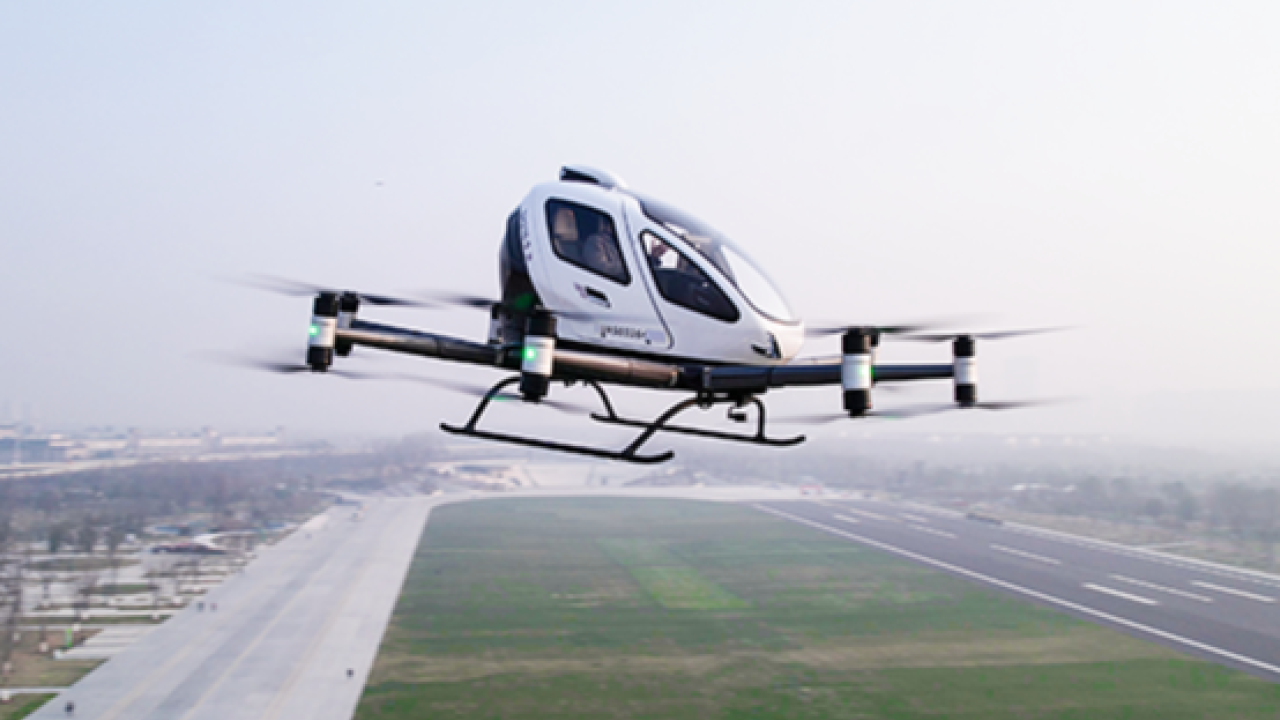The eVTOL Revolution Comes with Sky Capacity Challenges
Hector Pujadas
February 7, 2024

EHang has just announced a US$410,000 price tag for the EH216-S pilotless passenger-carrying eVTOL in markets outside China.
© EHang
In the rapidly evolving landscape of urban air mobility, electric vertical takeoff and landing (eVTOL) aircraft are not just a futuristic concept but an impending reality. With over 285 companies vying for a slice of this nascent market, the eVTOL revolution promises to redefine urban transportation.
However, the road to commercial viability and widespread adoption is fraught with complex challenges, particularly regarding sky capacity and infrastructure.
One of the primary issues facing the industry is the establishment of robust infrastructure. This extends beyond vertiports; it encompasses the development of sophisticated air traffic management and unmanned aircraft traffic management systems. These must cater to the unique operational dynamics of eVTOLs, which differ significantly from conventional aircraft.
The complexity of eVTOL infrastructure doesn't end with physical and digital systems; it extends to regulatory and zoning considerations. For instance, vertiports require careful planning in terms of location, accessibility, and integration with existing transportation networks. Moreover, infrastructure must accommodate future growth and technological advancements, particularly in urban environments where space is at a premium.
Standards Still Evolving
The regulatory landscape for eVTOLs is still in its infancy. Organizations like NASA, the FAA in the United States, and EASA in Europe are actively working to develop standards and regulations that ensure the safety and efficiency of operations. This process, however, is time-consuming given the diverse range of eVTOL designs and operational models.
Significant areas of focus are vertiport design and safety. In 2022, the FAA released new vertiport design guidelines, providing interim standards and guidance for infrastructure facilities and developers. These guidelines are expected to evolve into a performance-based design standard, shaping the process, cost, and timeline for constructing vertiports and/or adapting existing infrastructure.

The UK Civil Aviation Authority has just launched a consultation on design proposals for vertiports at aerodromes, paving the way for eVTOL operations. Pictured is Lilium's vision of an urban vertiport.
© Lilium
As the eVTOL industry grows, so will the need for skilled pilots and operators. Traditional training may not suffice due to eVTOL’s unique flight characteristics and potential for autonomous operations. This is compounded by the anticipated volume of eVTOL traffic, which necessitates a rethinking of pilot training and certification to ensure safety and efficiency in increasingly crowded skies.
The possibility of autonomous flights adds another layer of complexity. While the technology promises to alleviate some concerns about pilot shortages, it introduces new challenges in terms of regulatory approval, public acceptance, and safety.
Consumer Buy-in
Public acceptance is crucial. Concerns about safety, noise pollution, and the visual impact of vertiports and flying vehicles must be addressed to gain public trust. The industry must therefore engage in proactive communication and community engagement.
Environmental considerations are also paramount. While eVTOLs have the potential to reduce carbon emissions and traffic congestion in urban areas, the impact of their production, operation, and infrastructure must also be carefully managed to ensure sustainable development.
The industry stands at the precipice of a new era in urban air mobility. To realize its full potential, a coordinated effort among manufacturers, regulators, governments, and communities is essential. Developing comprehensive infrastructure, refining regulatory frameworks, enhancing pilot training, managing public perception, and ensuring environmental sustainability are critical steps on this journey.
The promise of eVTOLs to revolutionize urban transportation, reduce congestion, and contribute to a more sustainable future remains a compelling vision. The path forward requires collaboration, innovation, and a steadfast commitment to safety and community.
The eVTOL revolution is not just about creating new vehicles; it's about re-imagining urban mobility and reshaping cities. As industry stakeholders work together to address the challenges, the sky’s the limit for what eVTOLs can achieve.
[Hector Pujadas has extensive experience in the fast-paced aviation sector and is an expert in operational excellence, with proven project management skills. His methodologies drive profitability while overseeing cost reduction strategies, always by empowering individuals and aligning team efforts with a strategic vision.]
